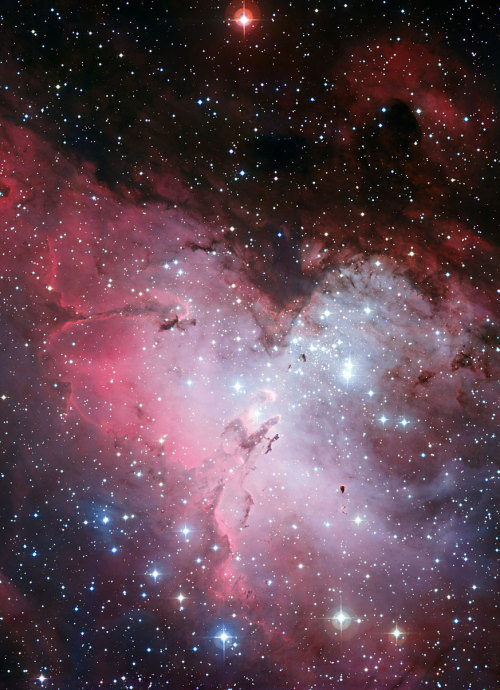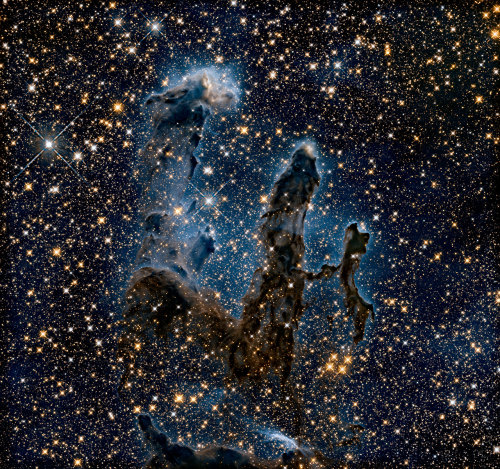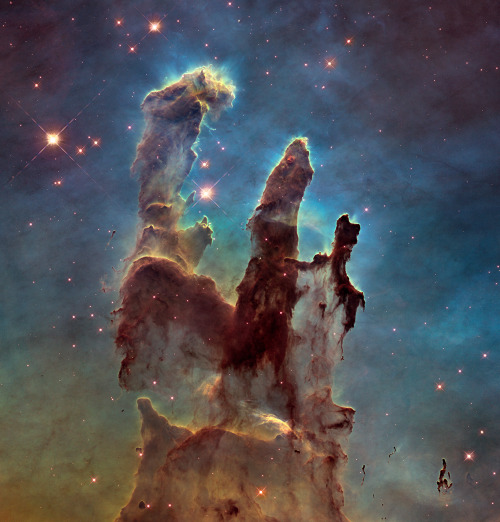Curate, connect, and discover
Eagle Nebula - Blog Posts

Mosaic of the Eagle Nebula, June 6, 2015. Image Credit: Adam Gustafson | Jamie Kern | BSU Observatory.
Imaged in luminance and photometric R, V and B filters. Approximately 2 hours total exposure time.
The Eagle nebula is a stellar nursery where new stars are born.

Mosaic of the Eagle Nebula, June 6, 2015. Image Credit: Adam Gustafson | Jamie Kern | BSU Observatory.
Imaged in luminance and photometric R, V and B filters. Approximately 2 hours total exposure time.
The Eagle nebula is a stellar nursery where new stars are born.

Obsessed with this magical wide-field view of the Eagle Nebula. At the center lies the iconic “Pillars of Creation” along with several other star forming regions. The cluster of bright stars to the upper right is NGC 6611, home to the massive and hot stars that illuminate the pillars. (Credit: ESO, La Silla Observatory)

The Pillars of Creation at the centre of M16 or the Eagle Nebula
Credits: NASA, ESA and the Hubble Heritage Team (STScI/AURA)
X-ray and Infrared Symphony of Chandra and Webb Unveiling the Secrets of Galaxies and Nebulae




NASA's Chandra X-ray Observatory and James Webb Space Telescope have delivered breathtaking composite images showcasing the beauty of two galaxies, a nebula, and a star cluster. These images, which combine X-rays from Chandra and infrared data from Webb, provide a mesmerizing glimpse into the hidden wonders of the universe.
Invisible to the unaided eye, the X-rays captured by Chandra and the infrared data obtained by Webb are transformed into vibrant colors that humans can perceive. To create these stunning composite images, NASA also incorporated data from other powerful telescopes, including the Hubble Space Telescope, the retired Spitzer Space Telescope, the European Space Agency's XMM-Newton, and the European Southern Observatory's New Technology Telescope.
Read full article here
![M16 [NGC 6611] Eagle Nebula [Kitt Peak Telescope]](https://64.media.tumblr.com/69443e31993f15df999d745879e1201e/tumblr_pc1nlh8sf01vhj0upo1_500.jpg)
M16 [NGC 6611] Eagle Nebula [Kitt Peak Telescope]


Sometimes… there’s more than meets the eye. 👀 You’re looking at two very different takes on an iconic image.
Human eyes can see only a small portion of the range of radiation given off by the objects around us. We call this wide array of radiation the electromagnetic spectrum, and the part we can see visible light.
In the first image, researchers revisited one of Hubble Space Telescope’s most popular sights: the Eagle Nebula’s Pillars of Creation. Here, the pillars are seen in infrared light, which pierces through obscuring dust and gas and unveil a more unfamiliar — but just as amazing — view of the pillars. The entire frame is peppered with bright stars and baby stars are revealed being formed within the pillars themselves. The image on the bottom is the pillars in visible light.
Image Credit: NASA, ESA/Hubble and the Hubble Heritage Team
Make sure to follow us on Tumblr for your regular dose of space: http://nasa.tumblr.com.

The Pillars of Eagle Castle What lights up this castle of star formation? The familiar Eagle Nebula glows bright in many colors at once. The above image is a composite of three of these glowing gas colors. Pillars of dark dust nicely outline some of the denser towers of star formation. Energetic light from young massive stars causes the gas to glow and effectively boils away part of the dust and gas from its birth pillar. Many of these stars will explode after several million years, returning most of their elements back to the nebula which formed them. This process is forming an open cluster of stars known as M16. Image Credit & Copyright: Emanuele Colognato & Jim Wood